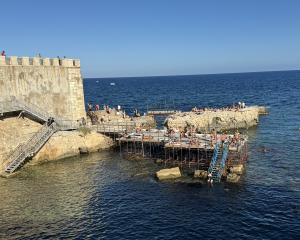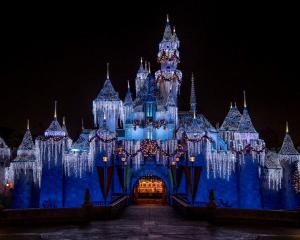Hollyford Valley has recently found itself on the hotly debated route of a controversial proposed new tunnel to Milford Sound. As Paul Rush discovered, its calm has not been ruffled yet.
One of the fondest memories of my youth was travelling through the newly-opened Homer Tunnel to Milford and returning for an overnight stay at Gunn's Camp in the Hollyford Valley.

But the real highlight was my evening stroll down the Hollyford Valley. Rich birdsong filled the air, wood pigeons and paradise ducks whooshed and squawked overhead and seven red deer eyed me cautiously from the track margins. I remember feeling like a teenage St Francis of Assisi, at one with nature, a fledgling member of the wider animal kingdom.
Regarded by many as New Zealand's most beautiful valley, the Hollyford is now accessible to everyone with a moderate level of fitness. A guiding company offers small-group, three-day nature walks with overnight stays in warm, welcoming lodges and a scenic flight back to civilisation.
Mike Talbot is to be our guide and I soon get a sense of his passion for the valley at our evening briefing in Te Anau's Luxmore Hotel.
"This tramp is not just about getting from A to B. We'll be stopping often to talk about botany, history and wildlife," he tells us.
Two surprises await me next morning. Gunn's Camp is still going strong with touches of Murray Gunn's quirky humour in the museum. The access road now extends 16km down the Hollyford to the Humboldt Creek Bridge.
Once across the impressive suspension bridge, we discover a beautiful botanic world. It's a Tolkienesque scene of ancient podocarp forest, where tangled rata vines and epiphytes cling tenaciously to massive tree trunks. The rich green canopy allows a few slanting rays of sunlight to dapple the mosses and lichens on the forest floor. Nature's delicate artistry is revealed everywhere; in unfurling gossamer-thin fern fronds and glistening water droplets on miniature orchid blooms.
There's a sublime peace in the forest, with the merest whisper of a breeze and the gentle tinkling of tiny streams hurrying to join the Hollyford River. The scene is dominated by water; in still pools among the trees, mini-cascades tumbling over boulders and silent streams tripping lightly over jumbles of stones.
The sheer size and steepness of the Darran Mountains is awe-inspiring. Just when we are getting used to gazing at the monumental beauty of the granite mountain backdrop, it disappears. Right on cue the dependable Hollyford rain begins to fall in earnest, which means that, when we stop to gain botanic insights, we don't need to dance the "Fiordland Foxtrot" to deter the sandflies.
Mike explains the vital role of broadleaf trees in forest regeneration; identifies some of the 108 mosses that are endemic to New Zealand and points out a green-hooded orchid that traps insects like a venus fly-trap to ensure they gather pollen. He gives us a bush-tucker sampling of fresh supplejack shoots. (The taste suggests broad beans.)
We learn to recognise red, silver and mountain beech trees and to distinguish between soft and hard tree ferns, sampling the nuts on the underside of the hard koru (the taste of walnut). Mike reassures us that he is not planning a botany exam but then points out a fuchsia tree that sheds its bark to rid itself of epiphytes.
"This is called the Silent Dog Tree," he says in a serious tone.
"Do you know why?"
We glance anxiously at each other at hearing this curious name until someone cottons on. "Oh, the tree has no bark!"
With 9km of track behind us we pass Sunshine Hut and hear the ear-splitting roar of a great cataract.
Hidden Falls is a tumultuous cascade of water plunging over a great rock wedged in a cleft, generating a cloud of mist and spray. From here on the leaf-litter track becomes soft and mushy as we climb Little Homer Saddle through tall beech forest.
As the day draws on I break into a song from my Tararua Tramping Club days in Wellington. The refrain is loud and hearty, but the lyrics fall a little short of today's standards of political correctness. However, it keeps me pressing onwards towards my destination.
There's a cheery greeting as we enter Pykes Lodge; a refreshing drink, hot shower and a private bedroom.
Tea and coffee is brewing, the fire is blazing, the drying room is ready and a three-course meal is being prepared. A torchlight walk to feed voracious eels and view clusters of glow-worms forms the evening's entertainment.
We begin day two with a short walk to Lake Alabaster, a glassy expanse of water with eerie dark shadows and mystical reflections. Captain Alabaster and Skipper Duncan were two early gold prospectors to visit this area. The local chief, Tutoko, greeted them wearing a full American Civil War uniform.
Explorers made their mark on the Hollyford; Patrick Caples named it after his birthplace in Ireland. Others obeyed the imperious call to seek out new lands: Dr James Hector, George Gunn, David McKellar, James McKerrow and William Homer. On the strength of Hector's report to the Otago Council, a settlement was established at Jamestown on Lake McKerrow, but the isolation doomed it to failure.
We take a thrilling jet-boat ride down the lake and visit the site of Jamestown, situated in a quiet bay.
There is no trace of the town's general store, five houses and pub. It's a poignant moment as we stand in contemplation of the privation the pioneer families faced for years, awaiting the promised road and watching the three-monthly supply ships turn away from the treacherous Hollyford bar. The poor Webb family buried five of their seven children in Jamestown.
Mike tells us a major fault line bisects Lake McKerrow.
"The Pacific tectonic plate meets the Indo-Australian plate directly under the boat now," he says.
"So we could see kangaroos today."
Surprisingly, the Hollyford should be a fiord like the other 14 "sounds" in Fiordland, but massive slips blocked the entrance, leaving a river valley instead of open water.
Our journey continues through ancient podocarp forest, and we linger under a 1000-year-old rimu tree. The fresh white flowers of the kamahi are blooming, in fine contrast to the crimson southern rata and the emerald mosses and velvet lichens of the understorey. We suddenly break out into a grassy clearing and receive a warm welcome from the hut wardens at Martins Bay Lodge.
A wildlife and heritage experience awaits us on our final day, beginning with a visit to the fur seal colony at Long Reef. By Jerusalem Creek we stand under a spreading sycamore tree above a hand-made slipway and hear the sharply distressing story of the Martins Bay postmaster. Big John Robertson launched his dinghy, rowed up Lake McKerrow and carried his mail bag over the untracked route to Queenstown every two weeks.
He repeated this arduous journey without respite for two years until the day he fell dead on his lounge floor.
His widow and four children were unable to move his body for nine days. Neighbour Daniel McKenzie carried sawn timber from Big Bay to build a coffin.
He had to sleep in the coffin in torrential rain as there was no room in the house. He buried John and the next morning planted a sycamore tree on the grave.
At the south end of the beach we stand among the remnants of Daniel McKenzie's homestead.
His family continued farming for many years after Jamestown was abandoned, driving their herds 250km to the Mossburn sales twice a year. It is hard to comprehend the unrelenting, harsh reality of their life and the isolation they endured.
The legendary Davey Gunn took over the run hold in 1926 and introduced tourism to the valley. One day a light plane crashed in the sea at Big Bay, killing one person and injuring four others. In a gallant mercy dash Davy ran to Lake McKerrow, rowed up the lake in the dark and ran to Marion Camp to summon help - a 90km non-stop journey on a rough blazed route in 20 hours. Two of the injured would not have survived another day without medical attention.
Interestingly, this intrepid cattleman turned tourist operator, whom our guide dubs "The greatest man who ever lived," earned such a reputation as New Zealand's own Davey Crockett, that 80% of his clients were women.
A recent entry in the Pyke River Lodge visitor's book reads, "I would have married Davey Gunn". Sadly, this man who was "made of whipcord and horseshoe nails" drowned when his horse stumbled during a river crossing and his body was never found.
A small aircraft is parked beside Martins Bay Lodge and we board with mixed emotions.
I'm thrilled at the chance of flying above Milford Sound, but reluctant to leave the Hollyford Valley. Its monumental beauty; heroic, heart-rending pioneer stories, its remoteness, wilderness and pristine forests remain a vivid memory. The Hollyford is much more than a walk - it's an extraordinary journey that satisfies the soul.
Footing it
The Hollyford Track guided walk is an all-inclusive three-day, 27km guided wilderness experience that starts in Queenstown with pick-ups from Te Anau.
The track traverses Fiordland National Park, which is a World Heritage Area. A professional track guide leads the trip with a maximum of 16 people in the group, and accommodation is provided in comfortable lodges. The track is well formed and suitable for people of all ages with a moderate level of fitness.
- Travel writer Paul Rush visited the region courtesy of Hollyford Valley Walk.












